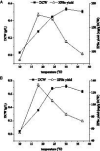Screening of exopolysaccharide-producing Enterobacter aerogenes NJ1023 and its cadaverine biosynthesis promotion
- PMID: 37577413
- PMCID: PMC10414541
- DOI: 10.3389/fmicb.2023.1200123
Screening of exopolysaccharide-producing Enterobacter aerogenes NJ1023 and its cadaverine biosynthesis promotion
Abstract
Enterobacter aerogenes, the gram-negative bacteria belonging to the family Enterobacteriaceae, lacks the ability to synthesize chemicals. However, in this study, a strain of Enterobacter aerogenes NJ1023 screened from the soil containing petrochemicals was found to be capable of producing extracellular polysaccharides (EPSs). After purification of the polysaccharide, the chemical composition and physicochemical properties of the polysaccharide were analyzed by UV-Vis spectra, FTIR spectroscopy and GC-MS, etc. The results showed that: The molecular weight of the polysaccharide produced by this strain was only 2.7×103 Da, which was lower than that reported in other polysaccharides from the same genus. The polysaccharide produced by E. aerogenes NJ1023 mainly comprised xylose, glucose, galactose, and N-acetylglucosamine with a molar ratio of 0.27: 4.52: 1.74: 0.2, which differed from those reported from the same genus. The results demonstrated that lower incubation temperatures and shaking speeds were more favorable for EPSs synthesis, while higher incubation temperatures and shaking speeds favored cell growth. Additionally, the EPSs produced by E. aerogenes NJ1023 significantly protected the Escherichia coli cells against cadaverine stress. Overall, the discovery of EPSs produced by E. aerogenes increased the diversity of bacterial polysaccharides and broadened the potential applications of this species.
Keywords: EPSs; Enterobacter aerogenes; cadaverine; cytoprotection; extracellular polysaccharides.
Copyright © 2023 Xie, Ye, Wan, Deng, Sun, He and Chen.
Conflict of interest statement
The authors declare that the research was conducted in the absence of any commercial or financial relationships that could be construed as a potential conflict of interest.
Figures






Similar articles
-
Screening, nutritional optimization and purification for phytase produced by Enterobacter aerogenes and its role in enhancement of hydrocarbons degradation and biofilm inhibition.Microb Pathog. 2018 Feb;115:159-167. doi: 10.1016/j.micpath.2017.12.047. Epub 2017 Dec 18. Microb Pathog. 2018. PMID: 29269246
-
Isolation and characterization of a bacteriophage polysaccharide.J Biol Chem. 1975 Nov 25;250(22):8696-703. J Biol Chem. 1975. PMID: 1184587
-
Structure of the capsular polysaccharide of Klebsiella type 73 (Enterobacter aerogenes).Carbohydr Res. 1981 Dec 1;98(1):105-13. doi: 10.1016/s0008-6215(00)87146-3. Carbohydr Res. 1981. PMID: 7317881
-
Biosynthesis and assembly of Group 1 capsular polysaccharides in Escherichia coli and related extracellular polysaccharides in other bacteria.Carbohydr Res. 2003 Nov 14;338(23):2491-502. doi: 10.1016/j.carres.2003.08.010. Carbohydr Res. 2003. PMID: 14670711 Review.
-
Biological activities and applications of exopolysaccharides produced by lactic acid bacteria: a mini-review.World J Microbiol Biotechnol. 2023 Apr 11;39(6):155. doi: 10.1007/s11274-023-03610-7. World J Microbiol Biotechnol. 2023. PMID: 37039945 Review.
Cited by
-
Bifidobacterium exopolysaccharides: new insights into engineering strategies, physicochemical functions, and immunomodulatory effects on host health.Front Microbiol. 2024 May 6;15:1396308. doi: 10.3389/fmicb.2024.1396308. eCollection 2024. Front Microbiol. 2024. PMID: 38770019 Free PMC article. Review.
-
Lactobacillus brevis-Derived Exosomes Enhance Skin Barrier Integrity by Upregulating Key Barrier-Related Proteins.Clin Cosmet Investig Dermatol. 2025 May 8;18:1151-1162. doi: 10.2147/CCID.S512793. eCollection 2025. Clin Cosmet Investig Dermatol. 2025. PMID: 40356846 Free PMC article.
-
The Impact of Bioactive Molecules from Probiotics on Child Health: A Comprehensive Review.Nutrients. 2024 Oct 30;16(21):3706. doi: 10.3390/nu16213706. Nutrients. 2024. PMID: 39519539 Free PMC article. Review.
References
-
- Butorac K., Novak J., Bellich B., Terán L. C., Banić M., Leboš P. A., et al. (2021). Lyophilized alginate-based microspheres containing Lactobacillus fermentum D12, an exopolysaccharides producer, contribute to the strain’s functionality in vitro. Microb. Cell Factories 20:85. doi: 10.1186/s12934-021-01575-6, PMID: - DOI - PMC - PubMed
-
- Cao C., Liu Y., Li Y., Zhang Y., Zhao Y., Wu R., et al. (2020). Structural characterization and antioxidant potential of a novel exopolysaccharide produced by Bacillus velezensis SN−1 from spontaneously fermented Da-Jiang. Glycoconj. J. 37, 307–317. doi: 10.1007/s10719-020-09923-1, PMID: - DOI - PubMed
LinkOut - more resources
Full Text Sources
Miscellaneous

